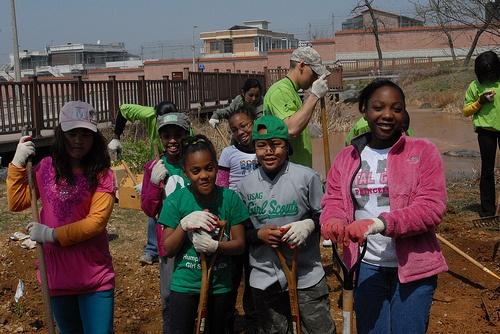
When most people think of Girl Scouts, they think of yummy cookies that are sold once a year by adorable little girls. Now Girl Scouts can be linked to sustainability. The Girl Scouts Forever Green (GSFG) Take Action program began in honor of the organization’s 100th anniversary. The Alcoa Foundation gave a two-year, $1.5 million grant to expand the program to 12 countries (Australia, Brazil, China, Guinea, Iceland, Italy,Jamaica, Mexico, Suriname, the United Arab Emirates, the United Kingdom, and the U.S.) By the end of the program, the results showed that it was a raging success with 639 million kilowatts of energy saved, 226 million gallons of water conserved, one billion pounds of carbon dioxide eliminated, and 120 million pounds of waste eliminated. In addition, there were 409,940 aluminum cans recycled, 123,753 native plants/trees planted, and 2,462 wildlife fed and sheltered.
"Although our girls might be famous for wearing the color green, it's clear that they are enthusiastic about 'going green' and working to preserve our natural resources," said Anna Maria Chavez, CEO, Girl Scouts of the USA in a statement. "As an organization committed to helping girls become leaders who make a difference in the world, we couldn't ignore their passion for the environment, and the generous contribution from Alcoa Foundation provided an outlet for girls to funnel their ecological energies."
The results of the GSFG program are detailed in a report. The program lasted from July 2011 to September 30, 2013, and during that time girls and their troops did thousands of projects to help the environment. There were three main areas of focus: Reduce Waste, Earth Hour and Rain Gardens. The goal of the Reduce Waste area of focus was to encourage people to use reusable bottles and recycle aluminum cans. For example, Girl Scout Brownies (ages seven to nine) created a PSA called the “Life of a Water Bottle” to show how plastic lives in the environment for years and causes pollution. A group of 12 girls and 13 community members from Girl Scouts of Greater Los Angeles participated in a project where they refilled their water bottles 32 times, and made and shared 12 reusable bags, plus they recycled 307 aluminum cans.Replacing incandescent bulbs with Energy Star qualified ones or other energy efficient bulbs was the goal of the Save Energy area of focus. Various Girl Scout troops participated in the Earth Hour event to turn off lights for one hour on the designated Saturday in March. The Girl Scouts of Colorado are a good example of a Save Energy project. They held Earth Hour events in two sites, and received a donation and support from Colorado’s Wal-Mart Foundation, which enabled them to give every participant a reusable bag and CFL lightbulb.
Rain gardens were created at schools, homes and others sites to increase green space and wildlife habitats, and improve water quality through infiltration, which reduces waterborne pollutants in streams, rivers and water supplies. The first rain garden was planted at the Houston Arboretum & Nature Center. Over 500 people participated in planting 169 native plants, totaling 1,800 square feet of rain gardens. They also installed a 2,500 gallon rainwater cistern to allow water to flow into the shady rain garden. A second rain garden in Houston was constructed by 56 people next to a designated wildlife area at the Environmental Institute of Houston.
Photo: Morning Calm Weekly

Gina-Marie is a freelance writer and journalist armed with a degree in journalism, and a passion for social justice, including the environment and sustainability. She writes for various websites, and has made the 75+ Environmentalists to Follow list by Mashable.com.














